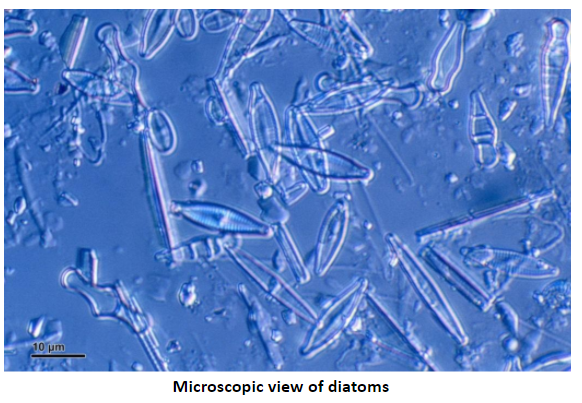
The Protist in which cell size decreases with each division are
A. Diatom
B. Dinoflagellates
C. Euglenoids
D. Slime molds
Answer
486.6k+ views
Hint: A particular Protist, when divided by mitosis, the daughter cells produced turn out to be smaller in size. These are the only organisms on this planet having a transparent, siliceous cell wall.
Complete answer:Diatoms are Protists i.e. belonging to the phylum Protista. Diatoms float on water as phytoplanktons and many aquatic animals feed on these. The specialized cells or spores called exospores are produced by diatoms that grow and develop to regain a normal size.
Diatom cells multiply (asexual reproduction) by mitotic divisions but their mitosis is quite unique. When they divide, each daughter cell has one valve and reproduction occurs by furrowing. So, after each cell division, the net size of the diatom gets smaller.

So, the correct option is A. Diatom
Note: These are unicellular and free-living algae. Some members form filaments, ribbons, or even star-shaped colonies. It has a cell wall made up of transparent, unique silica- often called ‘frustule’. Just like most other organisms, euglenoids, dinoflagellates, and slime molds also undergo normal mitosis in which the parent cell gives rise to equal-sized daughter cells.
Complete answer:Diatoms are Protists i.e. belonging to the phylum Protista. Diatoms float on water as phytoplanktons and many aquatic animals feed on these. The specialized cells or spores called exospores are produced by diatoms that grow and develop to regain a normal size.
Diatom cells multiply (asexual reproduction) by mitotic divisions but their mitosis is quite unique. When they divide, each daughter cell has one valve and reproduction occurs by furrowing. So, after each cell division, the net size of the diatom gets smaller.

So, the correct option is A. Diatom
Note: These are unicellular and free-living algae. Some members form filaments, ribbons, or even star-shaped colonies. It has a cell wall made up of transparent, unique silica- often called ‘frustule’. Just like most other organisms, euglenoids, dinoflagellates, and slime molds also undergo normal mitosis in which the parent cell gives rise to equal-sized daughter cells.
Recently Updated Pages
Master Class 11 Economics: Engaging Questions & Answers for Success

Master Class 11 Business Studies: Engaging Questions & Answers for Success

Master Class 11 Accountancy: Engaging Questions & Answers for Success

The correct geometry and hybridization for XeF4 are class 11 chemistry CBSE

Water softening by Clarks process uses ACalcium bicarbonate class 11 chemistry CBSE

With reference to graphite and diamond which of the class 11 chemistry CBSE

Trending doubts
What are the elders in Goa nostalgic about class 11 social science CBSE

Formaldehyde at room temperature is ALiquid BGas CSolid class 11 chemistry CBSE

Define least count of vernier callipers How do you class 11 physics CBSE

Distinguish between Mitosis and Meiosis class 11 biology CBSE

Why are forests affected by wars class 11 social science CBSE

Explain zero factorial class 11 maths CBSE




